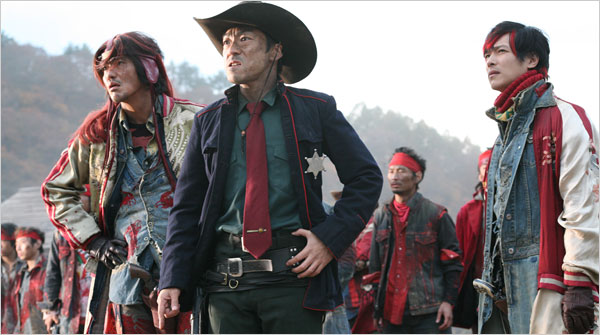|
Reviews of Recent Independent, Foreign, & Documentary Films in Theaters and DVD/Home Video

SUKIYAKI WESTERN DJANGO To call Sukiyaki Western Django an outright homage to the spaghetti western wouldn’t be entirely accurate. Director/co-writer Takashi Miike wrangles references from not only the original Italian-made Django (1966) but both Kurosawa’s Yojimbo and its remake A Fistful of Dollars, John Wayne vehicles, and the most ultra-violent of the Italian-born western form. (At one point, we literally hear “a man’s got to do what a man’s got to do” as if uttered for the first time.) Its story concerns a rivalry-cum-battle between two gangs, the Genji clan and the Heike clan, going toe-to-toe over some treasure hidden in an Old West mountain town. Then, naturally, a lone wildly talented gunman (Hideaki Ito) comes into town and is lured by each side to be used as an asset. There’s also a prostitute caught in the middle, an orphaned boy, and a 700-year-old man in a wheelchair played by Quentin Tarantino. More on that in a moment. What really makes Sukiyaki Western Django as successful as it is—and only insomuch as a B Western as opposed to a straight “great” film—is Miike’s manipulation of the genre. In truth, the plot isn’t very focused throughout, and it’s mostly due to the fact that one clan wears white and one wears red that we can keep track of them at all. But the film’s strengths are in its pure, unadulterated VISION as Miike leads his all-English speaking Japanese cast through a mad impressionist take on the western. When Miike stages a shoot-out, it’s no ordinary man-to-man gunfight but something that escalates with lots of blood and insane close-ups. The all-out battles between gangs become wild orchestrations of violence, mayhem, and bizarre comic timing. Indeed, as someone who’s seen many of the films in Miike’s varied and prolific career (he has over 70 credits as director since the early ’90s, according to IMDb.com), this is by far his most deranged bloodletting since the notorious Ichi the Killer. If one is wondering if it will be all just total insanity and nonsensical (and what the hell Tarantino is doing in the film) don’t worry—there is some artistry on display. Tarantino is completely uproarious in the opening scene and later surreally reappearing as the old man in the wheelchair. There are moments where Miike utilizes tilted angles and colored filters for appropriate and even emotional effects, unlike a lesser director throwing them in just for the heck of it. (There’s even a super “avant-garde” shot scene of flower petals peeling back to reveal a fetus!) And his cast is game for
just about anything, including a stretch where a maniacal character
becomes obsessed with a giant machine gun out of WW II and shooting
anything in sight (totally period incorrect, but what the hell—notice
how one gang leader quotes Shakespeare’s Henry VI to his
followers). Miike ends up having his cake and nearly eating it too,
appealing to those looking for another in his cannon of unique midnight
movie-style genre flicks as well as those searching for an art-house
Western. It might not be The Assassination of Jesse James by the
Coward Robert Ford, but it’ll do for now. Jack Gattanella
|

